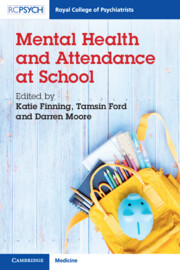Book contents
- Mental Health and Attendance at School
- Mental Health and Attendance at School
- Copyright page
- Contents
- Contributors
- Preface
- Acknowledgements
- Chapter 1 Mental Health and Attendance at School
- Chapter 2 School Attendance
- Chapter 3 Emotional Disorders and Attendance at School
- Chapter 4 Behavioural Disorders and Coping with School
- Chapter 5 Neurodevelopmental Disorders and Attendance at School
- Chapter 6 Educating a ‘New Me’ after an Acquired Brain Injury
- Chapter 7 School Influences on Attendance and Special Educational Needs
- Chapter 8 Supporting the Attendance of Vulnerable Children at School
- Chapter 9 School Attendance and Anxiety
- Chapter 10 Reflections on the Impact of Covid-19 on Children’s Education and Mental Health
- Index
- References
Chapter 7 - School Influences on Attendance and Special Educational Needs
Published online by Cambridge University Press: 24 March 2022
- Mental Health and Attendance at School
- Mental Health and Attendance at School
- Copyright page
- Contents
- Contributors
- Preface
- Acknowledgements
- Chapter 1 Mental Health and Attendance at School
- Chapter 2 School Attendance
- Chapter 3 Emotional Disorders and Attendance at School
- Chapter 4 Behavioural Disorders and Coping with School
- Chapter 5 Neurodevelopmental Disorders and Attendance at School
- Chapter 6 Educating a ‘New Me’ after an Acquired Brain Injury
- Chapter 7 School Influences on Attendance and Special Educational Needs
- Chapter 8 Supporting the Attendance of Vulnerable Children at School
- Chapter 9 School Attendance and Anxiety
- Chapter 10 Reflections on the Impact of Covid-19 on Children’s Education and Mental Health
- Index
- References
Summary
Persistent school absence has a negative effect on academic attainment and puts children and young people at risk of social isolation, dropping out of school, vulnerability to exploitation and exposure to criminality. Pupils are more likely to miss school frequently if they have poor mental health (particularly anxiety and depression), special educational needs and disability (SEND), a long-term health condition, or caring responsibilities, or if they suffer from bullying. Frequent absences can lead to a lack of confidence and anxiety upon returning to school. This chapter argues that schools in England can be hostile environments for children and young people with SEND. Persistent absence for pupils with both identified and unidentified SEND may result from pressure on schools and teachers to perform in academic league tables rather than provide environments for inclusion. The chapter suggests the importance of the cultural, social, physical and emotional factors that lead to absenteeism. These factors are illustrated by vignettes from research on school exclusions; school safety and social networks; school design; and collaboration and emotional wellbeing. What is required is a new focus on school factors related to absence that no longer views the pupil in deficit terms.
Keywords
- Type
- Chapter
- Information
- Mental Health and Attendance at School , pp. 130 - 144Publisher: Cambridge University PressPrint publication year: 2022
References
- 1
- Cited by



